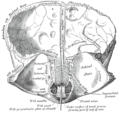Frontal sinus
| Frontal sinus | |
|---|---|
 | |
 Nose and nasal cavities | |
| Details | |
| Artery | supra-orbital, anterior ethmoidal |
| Nerve | supraorbital nerve |
| Identifiers | |
| Latin | sinus frontales |
| MeSH | D005626 |
| TA98 | A06.1.03.004 |
| TA2 | 3179 |
| FMA | 57417 |
| Anatomical terminology | |
The frontal sinuses are situated behind the brow ridges. Sinuses are mucosa-lined airspaces within the bones of the face and skull. Each opens into the anterior part of the corresponding middle nasal meatus of the nose through the frontonasal duct which traverses the anterior part of the labyrinth of the ethmoid. These structures then open into the hiatus semilunaris in the middle meatus.
Development
The frontal sinuses are absent at birth, but are generally fairly well developed between the seventh and eighth years, only reaching their full size after puberty. [1] The frontal bone is membranous at birth and there is rarely more than a recess until the bone tissue starts to ossify about age two. Consequently this structure does not show on radiographs before that time. Sinus development begins in the womb, but only the maxillary and ethmoid sinuses are present at birth. Approximately 5% of people have absent frontal sinuses.[2]
Structure
Frontal sinuses are rarely symmetrical and the septum between them frequently deviates to one or other side of the middle line. Their average measurements are as follows: height 28 mm, breadth 24 mm, depth 20 mm, creating a space of 6-7 ml.[3]
The mucous membrane in this sinus is innervated by the supraorbital nerve, which carries the postganglionic parasympathetic nerve fibers for mucous secretion from the ophthalmic nerve and supplied by the supraorbital artery and anterior ethmoidal artery.
Functions
Through its copious mucus production, the sinus is an essential part of the immune defense/air filtration carried out by the nose. Nasal and sinal mucosae are ciliated and move mucus to the choanae and finally to the stomach. The thick upper layers of nasal mucus trap bacteria and small particles in tissue abundantly provided with immune cells, antibodies, and antibacterial proteins. The layers beneath are thinner and provide a substrate in which the cilia are able to beat and move the upper layer with its debris through the ostia toward the choanae.
Pathology
Infection of the frontal sinus causing sinusitis can give rise to serious complications, as it is in close proximity to the orbit and cranial cavity (orbital cellulitis, epidural and subdural abscess, meningitis). [1]
Fractures may range from isolated anterior table fractures resulting in a simple aesthetic deformity to complex fractures involving the frontal recess, orbits, skull base, and intracranial contents; the risk of long term complication is high and the treatment controversial. [4]
Additional images
-
Frontal sinus
-
Frontal bone. Inner surface.
-
Medial wall of left orbit.
-
Lateral wall of nasal cavity.
-
Sagittal section of nose mouth, pharynx, and larynx.
-
Outline of bones of face, showing position of air sinuses.
-
Paranasal sinuses
-
Nose diagram
-
Frontal sinus
See also
References
- ^ a b Human Anatomy, Jacobs, Elsevier, 2008, page 210
- ^ The University of Texas Medical Branch, Department of Otolaryngology/Head and Neck Surgery
- ^ University of Texas Medical Branch
- ^ Strong, b, Frontal Sinus Fractures: Current Concepts, Craniomaxillofac Trauma Reconstr. 2009 October; 2(3): 161–175 at http://www.ncbi.nlm.nih.gov/pmc/articles/PMC3052655/
External links
- Anatomy photo:33:st-0703 at the SUNY Downstate Medical Center
- lesson9 at The Anatomy Lesson by Wesley Norman (Georgetown University) (latnasalwall3, nasalcavitfrontsec)
![]() This article incorporates text in the public domain from page 998 of the 20th edition of Gray's Anatomy (1918)
This article incorporates text in the public domain from page 998 of the 20th edition of Gray's Anatomy (1918)










